Feeds and Feeding
Credit: Biovision-Infonet
Supplementary feeding in particular for young chicks, is one of the most important means of preventing diseases.
- Store feeds in a dry and clean place always to avoid contamination and spread of diseases.
- Provide your poultry with clean water daily to avoid the spread of waterborne diseases, such as Fowl Cholera. Daily addition of EM to drinking water has been shown to help prevent diseases.
Why feed indigenous chicken?
Feeding is important so as to increase the production of meat and eggs from indigenous chicken. A lack of feed or water will reduce resistance to diseases and parasites, and subsequently increase flock mortality. It is important to note that even small flocks of indigenous chicken will starve during certain periods of the year (e.g drought, planting season when birds are confined, floods etc) when left to scavenge without supplementary feeding.
Egg production and growth are limited by access to feed and genetic potential. Local birds are the best converters of feed to eggs under fluctuating environmental conditions, although their production potential is much lower than genetically improved breeds.You may easily increase egg production and growth of local birds by giving supplementary feeds. Improved breeds also perform well under village conditions when given a steady supply of feeds. It is important to always start by making calculations of the cost-benefit and judge the risks involved before choosing the quantity and type of feed.
Feeds and feeding will vary between free range, semi-intensive and intensive systems of poultry production basically due to profitability. In the following we will focus on free-range and on semi-intensive systems and discuss the importance of feed requirements, feed types, feed mixing, feeding equipment, feed storage, feeding and watering.
What to feed?
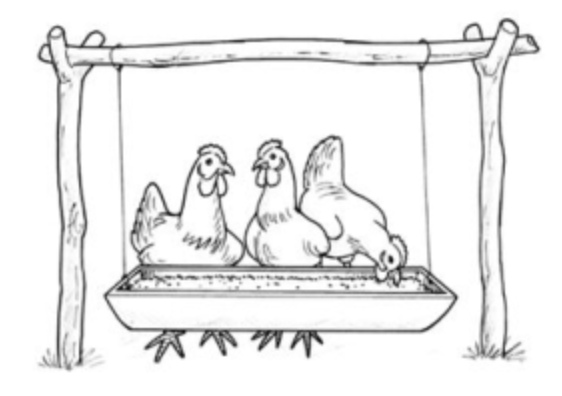
The composition and availability of feeds will vary, depending on the season, locality and production system. Poultry need feed containing energy and protein, as well as vitamins, minerals and water. The need for feed will change, depending on the age and status (chicken, grower, egg layer, broody hen) of the bird. The cheapest – and also often the best – way to supplement the diet of your poultry, is to use local resources. However, many vitamins and nutrients are destroyed if the feed is stored too long or under sub-optimal conditions, e.g. high humidity and heat. Knowledge of feed quality and sources of different feed types is important for feed safety.
If you have free range chicken, temporarily confined during planting season and during night, you can supply grains, by-products of grains or tubers besides the green forage and seeds they collect during scavenging. With a variety of feeds (plants and insects) also requirements for minerals, trace-elements and vitamins are likely to be met. Water should be available at all times. Young chicken should be fed easy to digest feeds that are energy and protein rich.
Scavenging
In a free-range or semi-intensive poultry rearing system, adult hens and cocks ought to be given enough time and space for scavenging in the surroundings daily. The best time for scavenging is early morning and late afternoon when there are plenty of insects and less heat. Chicks below six weeks of age should be confined. Supplementary feeds should be offered in the morning and evening when the birds come back for the night. Ad libitum clean water should be provided in shady areas during the day to avoid heat stress. If your production is based on improved breeds or hybrids for egg production, different types of commercial diets may be offered. These are divided into three distinct categories, with decreasing amount of protein as follows;
- A starter diet or (chick mash): high in protein (18%,11,8 Mj ME); offered from day old up to 8 weeks; Each chick will consume 2 kg during this period
- A growers’ diet/mash: lower in protein (14%, 11,6 Mj ME); offered from 9 weeks up to 18 weeks; Each grower will consume about 8 kg during this period
- A layer diet/mash: medium in protein (14%, 11,2 Mj ME); offered to hens from 19 to 75 weeks. Allow 120 g of feed per bird per day. Hens consume about 45 kg of feed annually
Note: The above quantities are a guide and will vary depending on the adult weight of the chicken, the feed quality and level of feed wastage.
Guide to feed management
Before buying, mixing, and storing feeds, it is important to understand some underlying principles of good feed management.
It is crucial to:
- Use local feed ingredients for local birds;
- Know or estimate the quality or feed value and prices of each feed ingredient;
- Buy missing feed ingredients, such as vitamins or protein sources locally from a stockist;
- Change the feed formulation depending on availability, quality or feed value and price;
- Reduce the flock size under free-range production system during lean seasons and when feed cost increases;
- When changing feeds always do it gradually;
- Avoid long storage periods;
- Use locally available materials such as tins or matchboxes for quantifying the different ingredients to be mixed. Grams or percentages do not work in practice;
- Store mixed feed or feed ingredients separately on a platform approx. 30 cm above the floor;
- Stop the entry of rats, pigeons, or other type of birds into the feed store;
- Make sufficient ventilation to ensure that feed ingredients are not wet due to humidity;
- Caution; Do not use feed ingredients that are mouldy, discoloured or infested with pests.
Water

Scavenging poultry can get diseases by drinking water from small ponds or puddles, as these can transfer water borne diseases and parasites. Poultry should get clean and fresh water all the time at the same place. This makes it is easy to medicate them.
Clean water should be given at least early in the morning and again in the evening when the birds are returning to the house for the night. It is important that all feeders and drinkers are kept clean to avoid disease infection through dirty feed and water.
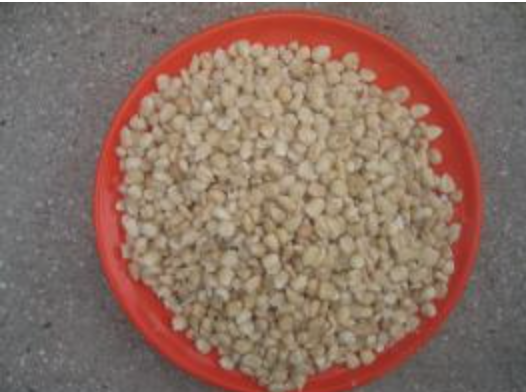
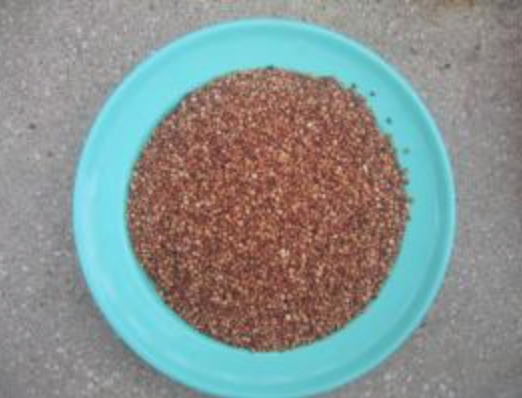
(c) A. Wachira, KARI, Kenya
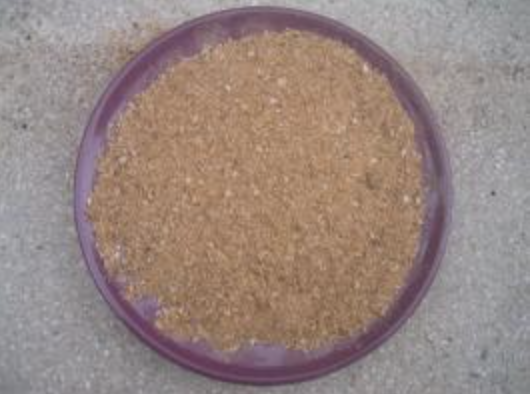
(c) A. Wachira, KARI, Kenya

(c) A. Wachira, KARI, Kenya
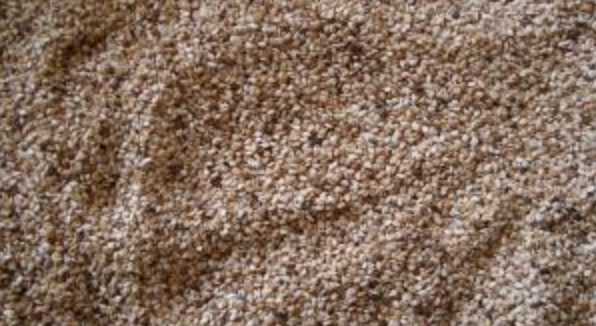
(c) A. Wachira, KARI, Kenya

(c) A. Wachira, KARI, Kenya
When buying commercial feeds, calculate whether it is profitable based on the market price for eggs or meat/live birds. If the product price is lower than the price of feed consumed by the birds to produce it, it is not economical to offer commercial feeds. Indigenous chicks may be offered commercial diets profitably from day old to six weeks of age.
Types of feeds
Energy feeds
As a rule 75% of a quality poultry diet is made up of energy feeds. Energy feeds are the most important feeds for maintenance requirements (e.g. body temperature, vital functions, exercise). Cereal grains, roots and tubers are the most important energy feeds. Examples of energy feeds are cereals like maize and its by-products (bran), sorghum, wheat and its by-products (bran), rice and its byproducts (bran, polishing), cassava root meal, yams and sweet potatoes.
Roots and tubers should be soaked in water for 60 minutes or cooked before drying to remove harmful substances and the proportion in the diet in general kept below 10%. Fat is also a good source of energy in particular in hot climates, as the heat produced during metabolism is less than from traditional energy feeds, e.g. cereals. Sources of fat are e.g.: tallow, lard, oil cake meals, hotel used oils and fat. Such oils and fats should only be given in small amounts, i.e. less than 10% of the total diet.
Protein
Protein is needed for growth and optimal health status. Normally no more than 20% of a poultry diet is made up of protein-rich feeds mainly due to high cost. Protein sources may originate from animals or plants. Examples of protein-rich local feeds are: Maggots, termite eggs, insects, worms, peas, beans, and oil cakes from e.g. ground nuts, cotton seeds, palm kernels, and coconuts. Animal byproducts such as meat meal or bone meal from chicken are not allowed, also fish meal is not allowed in organic farming. Synthetic amino acids are not permitted. Some harmful substances (anti-nutrients) are present in some protein-rich plants e.g. beans. As such their proportion in the diet should be low based on type and processing prior to feeding. Note that feeds processed with chemicals are not allowed in organic.
Minerals
Minerals are important for bone formation, eggshell formation and for optimal health status. The most important minerals are calcium and phosphorous. To produce strong egg shells, laying hens need free access to calcium (limestone or crushed shells). Mature birds are usually able to balance their mineral intake according to their requirements. When phosphorous rich feeds are added to the diet, they should be balanced with calcium rich feeds, since high levels of one mineral will cause deficiency of the other. Examples of sources for minerals are: bone meal, limestone and burned eggshells. The use of bone meal or eggshells is a good way of balancing calcium and phosphorus levels in the diet. Eggshells should always be scorched or cooked before re-use in diets to remove contaminants.
Vitamins
Scavenging birds get vitamins from eating green grass, vegetables, fresh cow dung and through sunlight. Vitamins A, B2, and D3 are important because many problems arise when birds are deficient. Sunlight and green grass or green fodder normally provide Vitamin A and D, whereas Vitamin B may come from fresh cow dung. Vitamin B may also be added by giving multivitamins. Additional vitamins are given in very small quantities and purchased from agrovet stores or feed stockists. Supplementary vitamins are usually not required when birds are left to scavenge. Confined or intensively management birds always need additional vitamins added into their feeds.
Simple feed mixing
It is advisable to make a semi-balanced diet for the small chicks from 0-6 weeks of age. Locally available ingredients should be dried in the shade (the sun may destroy important vitamins) and grounded in a mortar before mixing. Locally available containers such as plastic tins or matchboxes may be used for easy quantification of the different ingredients. Grams or percentages should be transferred into local quantities for field practice. Large ready-mixed quantities should only be stored, if adequate storage capacities are assured (see under “Twelve simple rules”). In general mixed feeds should not be stored for more than a few weeks to avoid contamination from mould, bacteria or rodents and to avoid losing vitamins. Above 8 weeks of age, poultry may be fed in a cafeteria system saving time and energy on mixing feeds. The cafeteria system is described below.
Table of Simple ration for supplementing local chicks from day-old to 8 weeks (total 930 g)
| Ingredient | Quantity |
| 1) Crushed maize/sorghum or millet | 1 kg tin |
| 2) Wheat/sorghum or millet bran | 1 kg tin |
| 3) Sunflower/sesame/groundnut cake | 2 match boxes |
| 4) Fishmeal/salt mix | 1 match boxes |
| 5) Sesbania/leucaena leaves | 2 match boxes |
Termites or maggots may also be added during the first 8 weeks. Depending on the types of crops grown in the locality cereals, oil cakes etc maybe substituted. Alternatively a commercial chick starter ration can be used from day old to 8 weeks of age. In this way you will ensure that the chicks have the daily requirements during the most vulnerable weeks.
Simple techniques for growing maggots and termites
Maggots and termites are a cheap source of protein in semi-intensive poultry production systems. However, they are a supplement to other feeds. Maggots or termites should be offered to young chicks since they require quality protein sources for optimal growth
Maggots may be grown by a simple technique. Blood, offal and cow dung are mixed in a large open pot. The pot is filled with 1/3 water. Flies will lay their eggs in the mixture and maggots hatch and feed on the mixture. Leave the pot open during daytime and closed during the night. After 5 – 10 days (depending on temperature) the maggots will be ready to pupate. Collect the maggots by gently pouring water into the pot. The maggots will float and you can then wash them and feed them directly to the birds. Remember to place the pot away from public places, as the smell at times may be offensive.
Growing termites
Take a pot with a short neck and a capacity of at least 10 litres. Fill it up with cow dung and straw and sprinkle a little water on content. Set the pot upside down with the opening on sandy soil. After one day and one night, the pot will be full of termites and you may empty the living contents in front of the hen house in the morning.
Other feedstuffs
Algae and water plants material have been considered appropriate for feeding poultry since they provide carotenoids and other fat-soluble vitamins. The carotenoids improve the colour of the egg yolks and together with vitamin E enhance the egg quality and the viability of the hatchlings. The deeper the egg yolk colour and pigmentation, the greater is the supply with vitamin A to the consumer.
Where available, the mixing of molasses with dried protein feeds have been shown to improve nutritional status of chicken.
Dung heaps from the waste of cattle, goats and sheep are excellent sources of insect protein but also may act s sources of parasites (e.g. coccidia) and other diseases.
Formulating feeds using Pearson square (Box method)
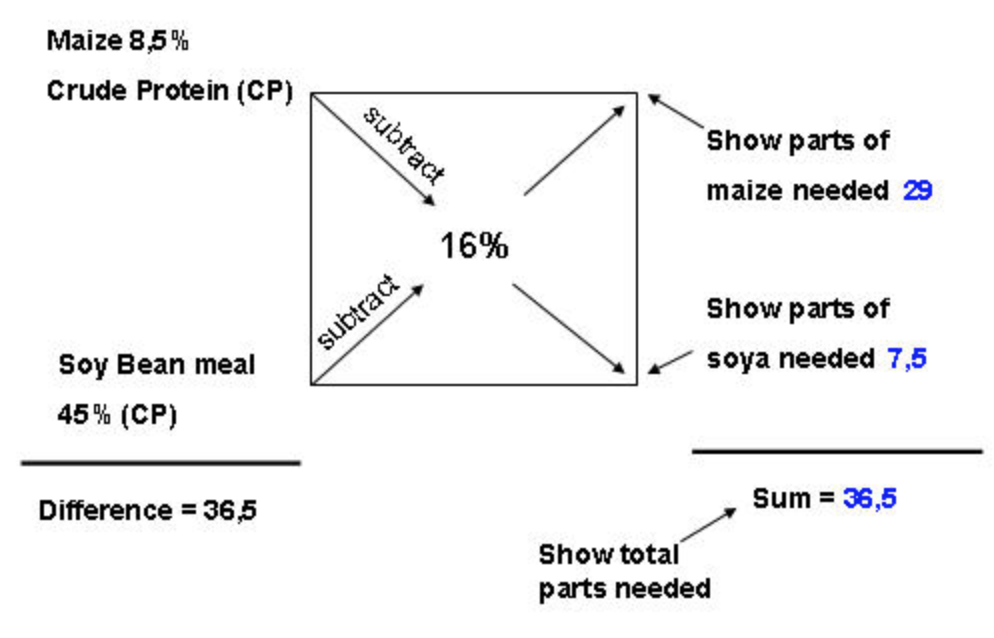
(c) A. M. Wachira, KARI, Kenya
It is possible to formulate poultry diets to balance for both energy and protein according to the requirement of specific diets i.e. Chick diets, Hens consume about 45 kg of feed annually One of the simple tools to apply is the Pearson square. It involves making corrections for basically two ingredients and not more. However, one should be conversant with the nutrient composition of the specific ingredients before applying this method.A worked example on the application of the method is indicated below Example:
Soy bean meal with 45% crude protein, mixed with maize (8.5% crude protein), to obtain a 16% crude protein ration. In these calculations, the parts are by weight.
To find the right combinations, work diagonally, subtracting the smaller numbers from the bigger number:
Step 1
16 – 8.5 = 7.5 Parts Soy bean meal
45 – 16 = 29 Parts of maize
Total of both feeds 36.5 parts, with 7.5/36.5 (=20,5%) soy bean meal and 29/36.5 (=79,5%) maize.
Examples of home made rations
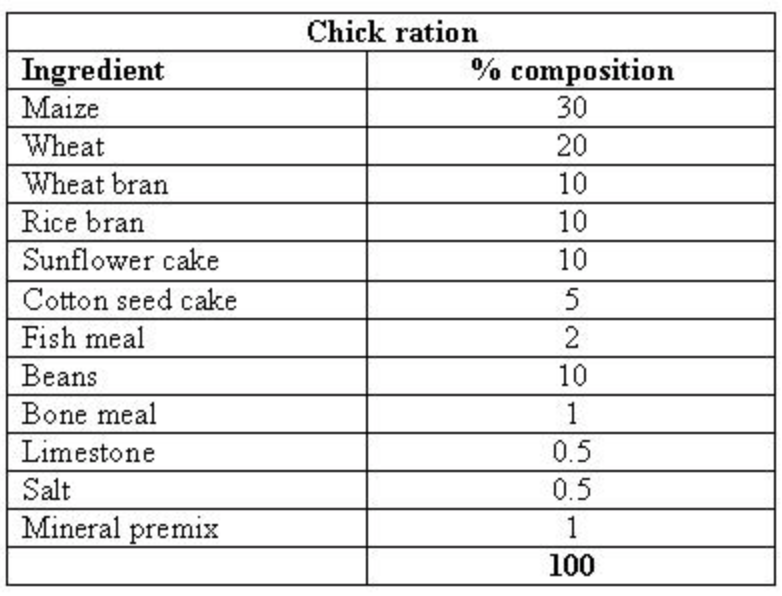
Bone and meat meal is not allowed, exchange with fish meal or beans

Bone and meat meal is not allowed, exchange with fish meal or beans

How much to feed in free range systems?
A major economic advantage of the free-range or semi-intensive production systems over the intensive systems is the ability of poultry to scavenge for in the surroundings. This so-called scavenging feed resource base (SFRB) will change over the seasons based on climate, geography and production system in the area on which the poultry scavenge for feeds. Depending on the season, the chicken may find nearly all they need in the surroundings (e.g. during harvest) or nothing (during lean season).
Table: Amount of feed at different ages of local poultry
| Age (wks) | Intake/bird/day (g dry weight) |
| 1 week | 12 – 15 |
| 2 weeks | 15 – 21 |
| 3 weeks | 21 – 35 |
| 4 – 6 weeks | 35 – 50 |
| 7 – 8 weeks | 55 – 60 |
| 16 – 27 weeks | 68 – 80 |
| 28 weeks | 100 |
Limit the quantity of feed offered to the birds daily to at least 30% – 50% of their full daily intake. Allow a maximum of 30 – 40 g/bird/day from week 4 – 6 and gradually reducing the supplementary feeding. At day old to 4 weeks young chicks will receive feed according to their needs. As the birds grow, they will gradually get a smaller portion of what they need, until they only get between 1/3 and half of their needs as adults. Economic benefits are calculating the break-even point from the sale of eggs and live birds relative to the cost of disease control, housing, labour and feeds.
To ensure sustained egg production, offer feeds when the chicken need it rather than less quantities during the harvest season and more during the lean season. Reduce the flock size through selling some chicken when feed costs are high rather than reducing the amount of feed given to each bird.
How to feed?
It is important to use simple local measures to administer feeds. By using a table, you can calculate how much feed to use. Fig. shows calculated daily feed requirements based on a flock of 1 cock, 4 hens and 15 three week old chicks.
Table: Simple calculation for daily feed requirements
| 1 cock: | 35 g. = 35 |
| 4 hens: | 4 x 35 g. = 140 |
| 15 chicks: | 15 x 25 g. = 375 |
| Total | = at least 550 g per day |
When using 1 kg containers (or a cup) measure the amount of feed the container holds, and then calculate the number of containers of feed needed daily. If the container holds 750 g of feed you will need to fill the container 3/4 full. To keep the birds hungry for scavenging, offer half the feed in the morning, which will be equal to a half full container. To avoid competition, feed the young chicks a little more than half in a separate shelter. Feed the hens next and finally before the feeder is empty feed the cock. When cocks are offered feed before the other birds, they over eat and leave less feed for the rest of the flock. Cocks are better at scavenging within the surrounding than the rest of the birds. Young chicks will need relatively more protein in their diet than adult birds hence the need to mix two different rations for young and adult birds, respectively. If you do not want to mix two different rations, you can alternatively give a little extra supplement of a good protein source to the young chickens, e.g. maggots and termites.
Cafeteria system
Adult birds are able to mix their own feed according to their needs. The best way to feed semi-intensively managed birds above 8 weeks of age is a cafeteria system, whereby various types of feeds are offered separately. An important condition is that feeds are palatable to the same extent. If not they will be refused even when they are needed in the ration
Feeders are divided into three compartments, enabling the poultry to choose the feed ingredient according to their needs.
In the cafeteria system, there should be at least one feeding compartment for:
A. Energy rich feeds, e.g. maize, millet, sorghum.
B. Protein rich feeds, e.g. beans, peas, oil cakes, maggots, termites.
C. Mineral rich feeds, e.g. burned eggshells.
An additional compartment for oil rich feeds may be added, e.g. tallow, oil cake meals, fish oil. By giving adult birds feeds in compartments, observe their feeding behaviour and avoid feeding unnecessary amounts and types of feed. For example, during harvest seasons you may find that they birds feed less on energy feeds in the evenings because there is plenty of cereal in the environment. You may also try out alternative feeds that the birds do not find tasteful. The cafeteria system is a good way of learning about your birds’ behaviour and taste.
Feeding Hybrid layers
Hybrid layers have quite easy feeding regimes, as the feed they need is manufactured and can be ready bought. However if you want to have nice yellow eggs also green vegetables wastes and forage such as grass, lucerne or kales needs to be provided. Preferably the greens should be hung up in a string so the birds have to jump a bit to reach them. This gives both good exercise and avoids too much mess to clean up later. Yolk colour maybe influenced by the genotype and the rate of egg production but feed composition is the major influencing factor. Both natural and synthetic sources of pigmenting egg yolks are in use commercially. Feeds stabilized with antioxidants such as vitamin E and A improve yolk colour pigmentation. Feed intake of laying hens depends on the quality of the feed, the body weight, its performance and environment. The following standards maybe used as a guide when feeding birds on a layers mash (11.7 Mj ME);
1) 2 kg body weight (for maintenance) needs 65g feed, for each 100 g difference in body weight add or subtract 2.5 g feed
3) For each gram of egg weight add 1 g
4) For each degree deviating from 20 degree Celsius add 1.5 g
Example calculation: if the average weight of the layer bird is 1.8 kg, with a daily egg weight of 56 g and temperatures of 24 degree Celsius (normal room temperature), the feed required will be as follows;
1. 1.8 kg hen: 65 – (2 x 2.5 g) = 60 g
2. 56 g egg weight: 56 g
3. 24 degree Celsius: 6 g
Total amount = 112 g feed per day
| Type of feed | Chick mash, 0-8 weeks | Growers mash, 9-18 weeks | Layers mash, 19-75 weeks |
| Protein % | 18 | 14 | 16 |
| Energy in Mj/kg | 11.7 | 11.5 | 11.4 |
Where the market demands a golden yellow egg yolk, the birds need to be provided with a scavenging area in a free range environment or provided with green leaves.
Feeding broilers (organic broilers cannot be slaughtered before 12 weeks of age)
Along with their recommended broiler feed, the birds also highly appreciate additions of greens for pecking and absorption of higher amounts of vitamins. AIM: Production of big broiler capons of 2 kg live weight (1.5 kg dressed weight at 6 – 8 weeks) In order to reach this aim a feed needs to contain the following:
Feed for the first 4 weeks (1.2 kg of broiler starter):
– Crude protein content greater than 22%
– Crude fiber less than 6%
– High energy content as close to 12.6 Mj /kg as possible
Feed for week 4-8 (3.5 kg of Broiler finisher):
– Crude protein content greater than 18%
– Crude fiber less than 7%
– Energy content as close to 12.6 Mj/kg as possible
Feedstuff problems
- Fish meal can give a fishy taste to meat and eggs and can contain excessive amounts of salt.
- Cassava tubers contain cyanide, which is toxic, and the tubers must be sliced and dried in the sun before feeding.
- Oil seed cakes can contain excessive amounts of oil and fibre, which lower digestibility of the feed.
- Beans and peas contain a number of anti-nutritional components and should be dried in the sun or cooked for a short period (chick pea and pigeon pea are exceptions and can be fed raw after crushing)
Feeders and drinkers
Feeders and drinkers are similar across the production systems. Feeders and drinkers should always be kept clean to prevent the spread of diseases. They should be big enough for all birds of the same age to feed at the same time. One metre trough or a 35 cm (diameter) tube feeder is big enough for 20 adult birds to eat and for 40 to drink. Feeders and drinkers may easily be produced out of local materials. An empty tin placed upside down on a plate forms a drinker. By keeping the tin upside down the water is not contaminated with dirt. Make two small holes near the rim diagonal to each other. Pour clean water in the can. Put a flat plate with a small rim on top and turn the can and plate upside down, while pressing them against each other.
Gently place the drinker on the ground. The rim of the plate should be low enough for young chicks to drink, but also high enough for adult birds to dip their wattles to keep them cool during the hot weather. Usually several waterers in different sizes should be used. Ensure that feeders minimize feed wastage. Feed wastage can be minimized when feeders are not filled to the top. Fill the feeders half full and check them regularly for refills.

(c) A. Wachira, KARI, Kenya
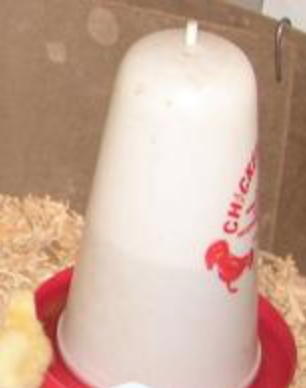
(c) A. Wachira, KARI, Kenya
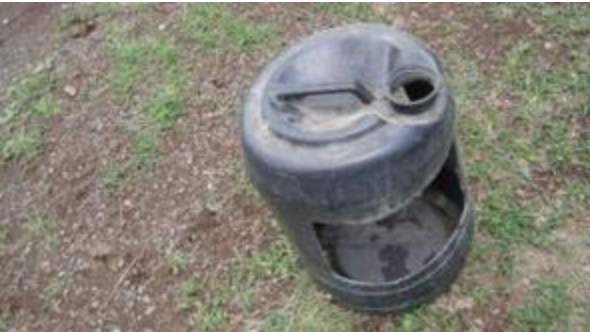
(c) A. Wachira, KARI, Kenya
Commercial feeders and drinkers may also be bought at the market, either in metal or plastic. However they are often expensive and normally not any better than locally produced feeders or drinkers.